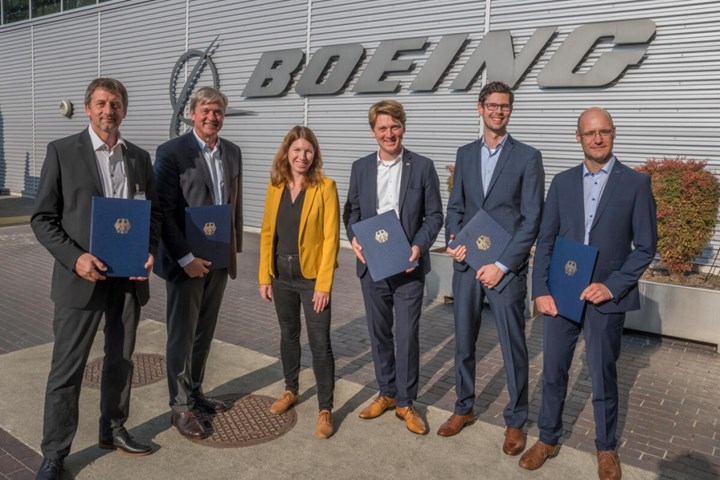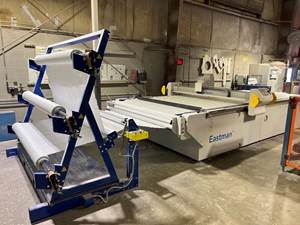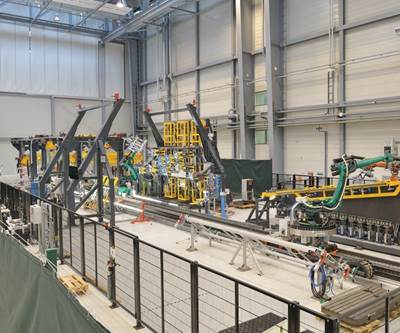Broetje-Automation works with Boeing Germany, consortium in “Shimless Assembly” project
Foundation for future aircraft programs aims for -75% manufacturing time, -25% cost via end-to-end digitization, tolerance compensation and force-controlled joining.
Dr. Anna Christmann presented the funding notification for the SHILA project during a delegation trip to the Boeing plant in Renton, Wash., U.S. where the Boeing 737 MAX is being built. From left to right: Markus Dirscherl, KEBA Industrial Automation; Dr. Michael Haidinger, Boeing; Dr. Anna Christmann, Federal Ministry of Economics and Climate Action; Norbert Steinkemper, Broetje-Automation; Michael Ernst, 3D.aero; Tobias Weber, Boeing. Photo Credit: Boeing
Under the leadership of Broetje-Automation (Rastede, Germany), an industrial consortium comprising German technology companies and universities are working with Boeing Germany to automate the assembly of future aircraft generations. Known as “SHILA” (standing for “shimless assembly,”) the project aims to lay a foundation for future aircraft programs and enable significant efficiency gains for a more sustainable, climate-friendly aviation industry. The consortium expects to reduce manufacturing times by up to 75% and manufacturing costs by up to 25% compared to the conventional assembly process.
“In the project, high-precision measurement systems are combined with innovative process technology and end-to-end digitization in such a way that manual compensation of component tolerances (so-called “shimming”) can be dispensed in the future, while at the same time enabling precision-fit, force-controlled joining,” Markus Stoyke, SHILA project manager at Broetje-Automation, explains. The company is an integrator of assembly technologies and specializes in automated assembly processes in the aerospace industry.
As SHILA is targeting upcoming aircraft programs, the capability to deal with composites is essential, as these programs most likely use composites to a large extent. With material behavior an important factor to be studied, the company will likely evaluate precision-fit, force-controlled joining processes for carbon fiber-reinforced polymer (CRFP)/metal material combinations.
The project, which is being carried out under the aerospace research program of the German Federal Ministry of Economics and Climate Action (BMWK), involves an industrial consortium comprising Boeing, Broetje-Automation, 3D.aero (Hamburg, Germany) and KEBA (Linz, Austria), with scientific support from the Institute of Production Management at the Technical University of Hamburg-Harburg and the WZL Machine Tool Laboratory at RWTH Aachen University, to prepare joining and assembly processes in aviation for future aircraft programs.
3D.aero is contributing state-of-the-art technologies to the project, including high-precision component measurement. In addition to industrial automation solutions in the field of quality assurance, the company offers optical sensor systems for 3D component measurement and inspection.
For high-precision component processing, KEBA Industrial Automation is using the newly developed “LeviSpin” in the SHILA project. LeviSpin is a drilling spindle with magnetic bearings that enables vibration-supported machining, thus enabling increased productivity with significantly improved quality. At the same time, quality-relevant part-specific process data is generated, which can be further processed as part of the digital twin.
“We are pleased to be working together with industrial partners such as Broetje-Automation, the German government and numerous research institutes throughout Germany to research the future of our industry and to develop groundbreaking new technologies,” Dr. Michael Haidinger, president Boeing Germany, says. “We would like to thank Dr. Christmann [the German government’s aerospace coordinator] and the Federal Ministry for Economic Affairs and Energy for the successful cooperation in the aeronautical research programs over the past few years.”
Related Content
Composites supply chain and production disruptions – how can AI and digitalization help?
Digitizing and creating the factory of the future is a journey, but it has the potential to help composites manufacturers address real-life disruptions and enable fast replanning of production operations for increased flexibility and enterprise-level performance.
Read MoreClemson Composites Center leads research in low-cost composite tooling
Innovative technology approach to use additive manufacturing and artificial intelligence to produce tools faster, at a lower cost and with less environmental impact.
Read MoreAdaptive composite elements for building facades exhibited at JEC World 2023
University of Stuttgart institutes use carbon and glass fiber composites, robotic fabrication, biomimetic design and digial twin/control to demonstrate adaptive facade elements for future buildings.
Read MoreFiberglass Cutting Operation at Hubbell’s Lenoir City Plant Moves to Automation
Automating fabric cutting operations saves Hubbell Lenoir City money and can produce composite products faster at less cost to support infrastructure expansion.
Read MoreRead Next
The future of CFRP aerostructures assembly
Metrology, robotics and inline inspection cut cost, reduce shimming and enable future automated production of three vertical tail planes per day.
Read MoreComposites in aircraft fuselage — now and in the future
What do some of the challenges of composites use on the 787 teach us about composites use on next-generation aircraft?
Read MoreCW’s 2024 Top Shops survey offers new approach to benchmarking
Respondents that complete the survey by April 30, 2024, have the chance to be recognized as an honoree.
Read More



























